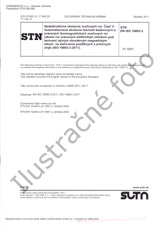Potrebujeme váš súhlas na využitie jednotlivých dát, aby sa vám okrem iného mohli ukazovať informácie týkajúce sa vašich záujmov. Súhlas udelíte kliknutím na tlačidlo „OK“.
ASTM D5224-12
Standard Practice for Compression Molding Test Specimens of Thermosetting Molding Compounds
Automaticky preložený názov:
Štandardná prax pre lisovanie skúšobných vzoriek termosetov hmoty na výrobu foriem
NORMA vydaná dňa 1.4.2012
Informácie o norme:
Označenie normy: ASTM D5224-12
Poznámka: NEPLATNÁ
Dátum vydania normy: 1.4.2012
Kód tovaru: NS-30337
Počet strán: 6
Približná hmotnosť: 18 g (0.04 libier)
Krajina: Americká technická norma
Kategória: Technické normy ASTM
Kategórie - podobné normy:
Anotácia textu normy ASTM D5224-12 :
Keywords:
allyl molding compound, amino molding compound, compression molding, phenolic molding compound, plastics, thermoset, Allyl molding compound, Amino molding compounds, Compression-molded plastic specimens, &ldquo,Dog-bone&rdquo, plastic specimens, Phenolic plastics, Thermosetting plastics, ICS Number Code 77.180 (Equipment for the metallurgical industry)
Doplňujúce informácie
| Significance and Use | ||||||
|
The conditions at which compounds are molded are known to influence the properties of the specimens. The degree of cure, elimination of knit-lines between particles, density of the part, and degradation of the polymer are among those factors which will be affected by the molding conditions. Thus it is important to conform to a standard set of conditions in order to have a valid comparison of properties between different compounds and different batches of the same compound. Molded specimens showing evidence of low-density areas due to trapped gases shall be discarded. A breathe step can be incorporated to eliminate this situation. If used, it is critical that the breathe step be as brief as possible to avoid precuring of the compound before full pressure is applied leading to poorly “knitted” areas and lower strength in the molded specimen. |
||||||
| 1. Scope | ||||||
|
1.1 This practice covers the general principles to be followed when compression molding test specimens of thermosetting molding compounds, such as phenolics, aminoplastics, melamine phenolics, epoxies, and unsaturated polyesters. 1.2 Molding conditions are given for amino, phenolic, and allyl molding compounds. The exact molding conditions will vary from material to material, and, if not incorporated in the material specification, shall be agreed upon between the purchaser and the supplier or determined by previous experience with the particular type of material being used 1.3 The values stated in SI units are to be regarded as standard. The values in parentheses are given for information only. 1.4 This standard does not purport to address all of the safety concerns, if any, associated with its use. It is the responsibility of the user of this standard to establish appropriate safety and health practices and determine the applicability of regulatory limitations prior to use. Note 1—This standard and ISO 295 address the same subject matter, but differ in technical content. |
||||||
| 2. Referenced Documents | ||||||
|
Podobné normy:
1.2.2013
1.6.2012
1.2.2009
1.9.2010
NEPLATNÁ
1.6.2008
NEPLATNÁ
1.6.2009



 STN EN 1369
STN EN 1369 Cookies
Cookies
